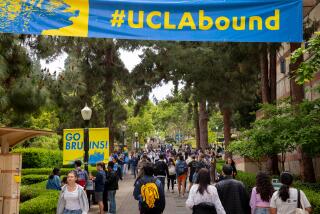Students Face College Costs That Outpace Inflation Rate
- Share via
NEW YORK — This year’s college freshmen will face some of the worst tuition news in years.
The first trickle of announcements from public and private universities show tuitions and other fixed fees heading 7% to 15% higher. For the ninth consecutive year, such increases will exceed the overall inflation rate.
Tuitions at public and private institutions shot up from 1981 to 1984, but had moderated somewhat in the last three years. In 1988-89, they were up an average of 5% at public schools and 9% at private schools, according to the College Board.
But signs are that next fall will bring that moderating trend to a halt at many colleges, and some students are already protesting.
George Washington University said freshman fees will rise by 20%, or $2,000, to $11,500, while returning students will be hit with a 10% increase.
By far the worst news is that economists see no letup in the cost pressures that have been pushing tuitions up throughout the 1980s.
“I see trends that have been going on for a decade that are not moderating: the need for financial aid, the rising cost of library acquisitions, the need to improve salaries,” said Richard Rosser, president of the National Assn. of Independent Colleges and Universities in Washington.
Faculty Salaries Lagging
Kent Halstead, an expert on college finance and director of Research Associates of Washington, calculates that faculty salaries, which averaged $37,000 in 1988, are still $4,000 below 1973 levels in terms of purchasing power, allowing for inflation. He figures that even with the huge tuition increases marking most of the 1980s, faculty salaries have still only recouped half the losses suffered due to inflation in the ‘70s.
“Catch-up is still the rule with faculty salaries,” Halstead said.
Library costs have likewise soared this past year, according to several college officials who blame the weak U.S. dollar for driving up the costs of foreign-printed books and research journals.
At George Washington, library acquisition costs rose 30% to 50% last year, said Robert A. Chernak, vice president for student and academic support services. Such costs, along with a 6% rise in faculty salaries, were key factors behind the $2-million operating deficit that led to next fall’s tuition increase.
Princeton University projects a $1.5-million deficit and recently announced a higher-than-anticipated 6.9% tuition increase, partly because of soaring library costs, said spokeswoman Jacquelyn Savani.
Savani added that the 1987 stock market crash had an apparent psychological impact on college donors, turning them more cautious even though the market has since made up the ground it lost. Changes in federal tax law making charitable giving less advantageous have put a further damper on college fund raising and are adding to the upward pressure on tuition, she said.
“One has to scale back one’s assumptions about the kind of income you can get from (fund-raising) campaigns,” she said.
Among other private institutions, rates will rise 12.5% at Syracuse University, 7.5% each at Brown University and Stanford University, 8.3% at Lehigh University and 8.5% at Lafayette College.
Several other schools besides George Washington are starting two-tier tuition systems of whopping increases for freshmen and lesser ones for returning students. Seton Hall University will charge freshmen 19.6% more next fall, while upper-division tuition will rise 10.8%.
Johns Hopkins University, citing a projected $3-million to $6-million deficit in its School of Arts and Sciences, set increases of 16.6% for freshmen and 8.3% for returning students. Duke University and the University of Chicago have similar two-tiered structures.
Financial aid costs have also soared at private institutions. At Cornell University, aid costs will reach $17.8 million next fall, compared with just $5.1 million in 1981, according to spokesman Sam Segal.
Cost of Financial Aid
Overall, the nation’s private colleges are spending $3.5 billion on financial aid, compared with $900 million in 1979, a fact Rosser blamed on cuts in federal aid programs.
The first signs are not much better in the public sector, which is generally slower to announce fall tuitions.
During the last three years, public universities had moderated their average tuition hikes to 5% to 6%, after increases that reached a high of 20% in 1982-83. But higher education officials note growing sentiment in many states, especially those with budgetary problems, to boost students’ share of the cost of public college.
“Public universities are now such a tremendous deal,” Halstead said. “There is a genuine shift in philosophy in many states that there ought to be more of a ‘user tax’ to support public education.”
On average, tuition and fees cover 25% to 33% of the cost of an education at public universities, compared to about 80% at private schools, said Robert Aaron, a spokesman for the National Assn. of State Universities and Land Grant Colleges.
“It is fair to say that states in fiscal stress are looking for ways to diminish their higher education burden and are looking for students and parents to pay a larger share,” Aaron said.
Texas public colleges are raising tuitions for residents by 12.5%. And students have protested an Oklahoma state regents’ proposal, which still awaits legislative approval, to raise freshmen tuition at the University of Oklahoma and Oklahoma State University by 19.7%.
7% Hike in New Jersey
New Jersey state colleges will charge students about 7% more next fall, about $150-200 per student, according to Darryl Greer, executive director of the state’s College Governing Boards Assn.
Former U.S. Secretary of Education William J. Bennett used to mince no words in regularly lambasting higher education for raising tuitions while doing little to curb what he considered waste and mismanagement.
By contrast, the current education secretary, former Texas Tech University President Lauro F. Cavazos, pulled his punches in a statement released by his office.
“Most certainly, the projected rise in college tuition costs is a concern to me,” he said, acknowledging the challenge for college administrators “in meeting rising costs while at the same time keeping tuition within potential students’ reach.”
At the University of Oklahoma, about 40 students chained themselves in protest to the administration Building last November when tuition plans were announced.
“There’s a chance that we may be locked out of an education,” said protest organizer J. P. Blackwood, a senior from Bartlesville. “It (tuition) is on the verge of having doubled since I’ve been here.”
More to Read
Sign up for Essential California
The most important California stories and recommendations in your inbox every morning.
You may occasionally receive promotional content from the Los Angeles Times.










